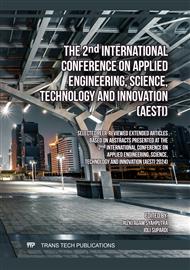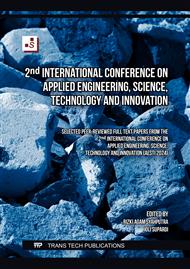[1]
S. Zhironkin and M. Cehlár, "Coal Mining Sustainable Development: Economics and Technological Outlook," Energies, vol. 14, no. 16, p.5029, Aug. 2021.
DOI: 10.3390/en14165029
Google Scholar
[2]
M. Yanis, M. Marwan, and N. Ismail, "Efficient Use of Satellite Gravity Anomalies for mapping the Great Sumatran Fault in Aceh Province," Indones. J. Appl. Phys., vol. 9, no. 02, p.61, 2019.
DOI: 10.13057/ijap.v9i2.34479
Google Scholar
[3]
U. Muksin et al., "AcehSeis project provides insights into the detailed seismicity distribution and relation to fault structures in Central Aceh, Northern Sumatra," J. Asian Earth Sci., vol. 171, no. November 2018, p.20–27, 2019.
DOI: 10.1016/j.jseaes.2018.11.002
Google Scholar
[4]
Y. Muhammad, A. Faisal, A. Yenny, Z. Muzakir, M. Abubakar, and I. Nazli, "Continuity of Great Sumatran fault in the marine area revealed by 3D inversion of gravity data," J. Teknol., vol. 83, no. 1, p.145–155, 2021.
DOI: 10.11113/jurnalteknologi.v83.14824
Google Scholar
[5]
K. Sieh and D. Natawidjaja, "Neotectonics of the Sumatran fault, Indonesia," J. Geophys. Res. Solid Earth, vol. 105, no. B12, p.28295–28326, 2000.
DOI: 10.1029/2000jb900120
Google Scholar
[6]
D. H. Natawidjaja, "Updating active fault maps and sliprates along the Sumatran Fault Zone, Indonesia," IOP Conf. Ser. Earth Environ. Sci., vol. 118, no. 1, p.0–11, 2018.
DOI: 10.1088/1755-1315/118/1/012001
Google Scholar
[7]
D. T. Sandwell and W. H. F. Smith, "Global marine gravity from retracked Geosat and ERS-1 altimetry: Ridge segmentation versus spreading rate," J. Geophys. Res. Solid Earth, vol. 114, no. 1, p.1–18, 2009.
DOI: 10.1029/2008JB006008
Google Scholar
[8]
A. F. Pohan et al., "Utilization and modeling of satellite gravity data for geohazard assessment in the Yogyakarta area of Java Island, Indonesia," Kuwait J. Sci., vol. 50, no. 4, p.499–511, 2023.
DOI: 10.1016/j.kjs.2023.05.016
Google Scholar
[9]
N. R. Cameron et al., Peta geologi lembar Takengon, Sumatera, 2nd ed. Bandung, Jawa Barat: Pusat Survei Geologi, Pemerintah Republik Indonesia, 2007. [Online]. Available: https://geologi.esdm.go.id/geomap/pages/preview/peta-geologi-lembar-takengon-sumatera
DOI: 10.32693/jgk.10.2.2012.220
Google Scholar
[10]
G. Dipatunggoro, "Sumberdaya Batubara Kawasan Blok Pt. Teunom Resources, Kab. Aceh Barat, Propinsi Nanggroe Aceh Darussalam," Bull. Sci. Contrib. Geol., vol. 5, no. 1, p.49–60, 2007, doi: https://doi.org/10.24198/bsc%20geology.v5i1.8134.
Google Scholar
[11]
D. R. Putri, M. Nanda, S. Rizal, R. Idroes, and N. Ismail, "Pemetaan endapan mineral teralterasi hidrotermal menggunakan analisis citra landsat 8 di sekitar Gunung Api Bur Ni Geureudong, Kabupaten Bener Meriah, Aceh," IOP Conf. Ser. Earth Environ. Sci., vol. 254, no. 1, p.1–26, 2020.
DOI: 10.1016/j.epsl.2021.116765
Google Scholar
[12]
D. R. Putri, N. Ismail, R. Idroes, S. Rizal, S. Nur, and M. Nanda, "Analysis of Land Surface Temperature (LST) in Bur Ni Geureudong Geothermal Field, Aceh, Indonesia Using Landsat 8 OLI / TIRS Images," Chiang Mai Univ. J. Nat. Sci., vol. 20, no. 4, p.1–13, 2021.
DOI: 10.12982/CMUJNS.2021.084
Google Scholar
[13]
B. Dejene, Y. Fujimitsu, J. Nishijima, and H. Saibi, "Geothermics Interpretation of gravity data to delineate the subsurface structures and reservoir geometry of the Aluto – Langano geothermal field , Ethiopia," Geothermics, vol. 94, no. February, p.102093, 2021.
DOI: 10.1016/j.geothermics.2021.102093
Google Scholar
[14]
C. Pocasangre, Y. Fujimitsu, and J. Nishijima, "Interpretation of gravity data to delineate the geothermal reservoir extent and assess the geothermal resource from low-temperature fluids in the Municipality of Isa, Southern Kyushu, Japan," Geothermics, vol. 83, no. May 2019, p.101735, 2020.
DOI: 10.1016/j.geothermics.2019.101735
Google Scholar
[15]
M. Sarkowi and R. C. Wibowo, "Geothermal Reservoir Identification based on Gravity Data Analysis in Rajabasa Area- Lampung," Ris. Geol. dan Pertamb., vol. 31, no. No. 2, p.77–79, 2021.
DOI: 10.14203/risetgeotam2021.v31.1164
Google Scholar
[16]
R. Yamazaki-Honda, "Promoting Coherence Among Disaster Risk Reduction, Climate Change Adaptation, and Sustainable Development for Disaster Resilience," J. Disaster Res., vol. 17, no. 6, p.1015–1021, 2022.
DOI: 10.20965/jdr.2022.p1015
Google Scholar
[17]
C. Dickinson, A. Aitsi-Selmi, P. Basabe, C. Wannous, and V. Murray, "Global Community of Disaster Risk Reduction Scientists and Decision Makers Endorse a Science and Technology Partnership to Support the Implementation of the Sendai Framework for Disaster Risk Reduction 2015–2030," Int. J. Disaster Risk Sci., vol. 7, no. 1, p.108–109, Mar. 2016.
DOI: 10.1007/s13753-016-0080-y
Google Scholar
[18]
S. Luna and J. Montaño, "From MDGs to SDGs: A Transformative 2030 Agenda for Sustainable Development," in Mexico and the Post-2015 Development Agenda, New York: Palgrave Macmillan US, 2017, p.53–65.
DOI: 10.1057/978-1-137-58582-0_3
Google Scholar



